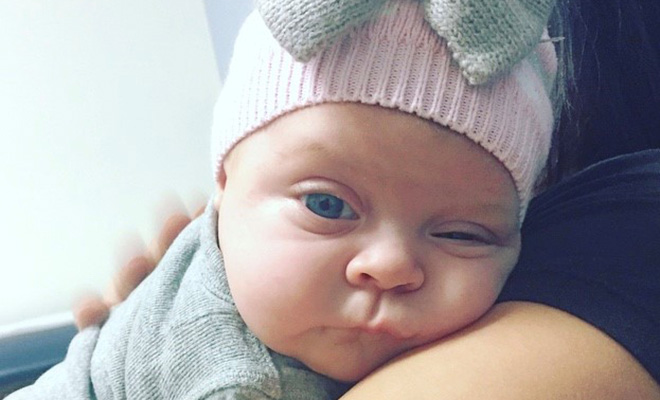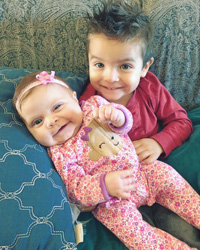Newborn Baby Girl at Lucile Packard Children’s Hospital Stanford is First in Western U.S. to Undergo Bloodless Open-Heart Surgery
Lola Garcia of Hemet, California is the smallest infant in North America to undergo such a procedure without a blood transfusion

For release: February 7, 2018
By Erin Digitale
Physicians at Lucile Packard Children’s Hospital Stanford have performed open-heart surgery without a blood transfusion for the smallest infant ever to undergo such a procedure in North America.
The surgery, on October 31, was done in a 10-day-old baby girl born in Hemet, California with a serious congenital heart defect. Meticulous planning and execution of the surgery, an arterial switch procedure, allowed the medical team to surmount daunting technical challenges of treating a 7-pound open-heart patient without giving blood. It is the first bloodless open-heart surgery performed in an infant in the Western United States.
“If you can do surgery safely and effectively without transfusion, there are several medical benefits,” said Frank Hanley, MD, chief of pediatric cardiac surgery at the hospital’s Betty Irene Moore Children’s Heart Center and one of two surgeons who performed the procedure. He said patients who do not receive blood products have fewer post-surgical complications, provided they do not lose too much blood. “You have to be able to do the surgery safely and not have the patient’s red blood cell count drop too low,” Hanley said.
A severe heart defect

From the moment of her birth on Oct. 21, little Lola Garcia struggled to breathe. She and her parents, Felisa and Jared Garcia of Hemet, California, were rushed to a children’s hospital near the family’s home.
Lola was diagnosed with transposition of the great arteries, a rare condition in which the heart’s major arteries are not connected correctly. Normally, the blood follows a single figure-eight-shaped circuit through the heart and lungs, then back to the heart and out to the body to supply oxygen to the internal organs and the brain. In Lola’s heart, the blood made two separate circuits — from the heart to the lungs and back, and from the heart to the body and back. The normal figure-eight was separated into two poorly connected loops. Her brain and other organs did not get enough oxygen.
“They said she would definitely need heart surgery, and most likely a blood transfusion, to correct the problem,” said Felisa. “We were happy there was a solution, but when they said ‘transfusion,’ my heart dropped.” The Garcia family are Jehovah’s Witnesses; they requested that Lola’s surgery be done without a blood transfusion because of their religious beliefs.
Although many hospitals now offer bloodless surgery for adults, the challenges of avoiding transfusion are much greater in newborns who need open-heart procedures. Several hospitals around the country turned the family down. But the pediatric cardiothoracic surgery team at Packard Children’s offered to attempt baby Lola’s arterial switch procedure without transfusing blood.
“Very few people have the technical expertise to do this,” said Vamsi Yarlagadda, MD, a pediatric cardiologist at Packard Children’s who cared for Lola.
Technical hurdles
During surgery, Lola needed to be connected to a heart-lung machine, which would pump her blood through a circuit of tubing and membranes for re-oxygenation.
The machine’s tubing is primed with saline that mixes with the patient’s blood. For an adult, the volume of saline in a standard heart-lung machine does not dilute the blood enough to be dangerous, but a 7-pound newborn has less blood to begin with. Connecting Lola to a standard heart-lung circuit would have dangerously lowered her red blood cell count.
In the past, the problem has been solved by transfusing blood. For Lola, the Packard Children’s team took a different approach.
“We used a miniaturized heart-lung circuit so that we could use a much lower priming volume of saline,” Hanley said. The team of surgeons, anesthesiologists, cardiologists and other experts also planned every step of Lola’s care to minimize blood loss, monitoring her with as few blood draws as safely possible and picking surgical techniques and materials with minimal blood loss in mind. Hanley and pediatric cardiothoracic surgeon Katsuhide Maeda, MD, operated together to enable them to perform the surgery as precisely as possible. “There were multiple decisions we made before, during and after surgery to minimize the likelihood of bleeding,” Hanley said.
Still, the team could not guarantee in advance that Lola would not need a transfusion. California state law gives physicians authority to decide to administer blood to a minor in emergency situations, even if the parents disagree. When they shared their plan with Felisa and Jared Garcia before surgery, the physicians explained the steps they would take to reduce blood loss, and told the parents they had set a safe lower threshold for Lola’s red cell count. “If it reached the threshold, we planned that we would evaluate Lola for negative effects, and if she was showing those, we would give blood,” Hanley said.
“Stanford accommodated us really well,” said Jared Garcia. During the 7-hour surgery on Oct. 31, the surgeons gave the parents hourly updates on Lola. “We were really nervous, but we were comforted because of those two doctors,” Felisa said.
During and after surgery, Lola’s red blood cell count stayed in the safe range. As she recovered, the family and doctors soon saw the medical benefits of her bloodless procedure.
“I couldn’t believe how fast she was healing,” Jared said. “Dr. Yarlagadda had said she would be in the hospital for at least a month, but we went home in less than two weeks. It was great.”
Even when the blood type between donor and recipient is matched, transfusions introduce foreign materials into the body, Yarlagadda said. Receiving a transfusion may increase patients’ risk of inflammation, and some data suggests that patients who are transfused stay longer in the intensive care unit.
The success of Lola’s procedure gives the team confidence that they will be able to continue to reduce their use of blood products, both for medical reasons and to accommodate patients’ religious beliefs.
Now three months old, Lola is at home with her parents and two-year-old big brother, CJ. Her heart is working well, and she’s a happy baby who loves to smile at everyone in her family, her parents say.
“Lola is doing fantastic; she looks phenomenal,” Hanley said. “Our team is excited to build this program that will help many other children and families in the future.”
About Stanford Medicine Children's Health
Stanford Medicine Children’s Health, with Lucile Packard Children’s Hospital Stanford at its center, is the Bay Area’s largest health care system exclusively dedicated to children and expectant mothers. Our network of care includes more than 65 locations across Northern California and more than 85 locations in the U.S. Western region. Along with Stanford Health Care and the Stanford School of Medicine, we are part of Stanford Medicine, an ecosystem harnessing the potential of biomedicine through collaborative research, education, and clinical care to improve health outcomes around the world. We are a nonprofit organization committed to supporting the community through meaningful outreach programs and services and providing necessary medical care to families, regardless of their ability to pay. Discover more at stanfordchildrens.org.
Connect with us:
Download our App: